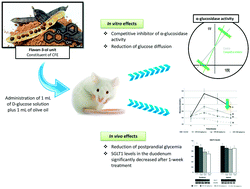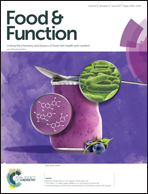Fiber purified extracts of carob fruit decrease carbohydrate absorption
Abstract
The postprandial state plays a central role in the development and setting of chronic diseases. Condensed tannins (CT) are polyphenols with a known ability to modify carbohydrate digestion and absorption. The high concentration of CT in the pulp of carob fruit suggests a potential antidiabetic effect. The aim of this work was to analyze the in vitro and in vivo effects of carob fruit extract (CFE) on the digestion and absorption of carbohydrates. α-Glucosidase activity and glucose diffusion were tested in vitro using 0.5, 1, 2 and 5 mg mL−1 CFE concentrations. Two in vivo absorption studies, acute and subchronic, were carried out in four groups of 6 two-month-old male Wistar rats (control and CFE 25, 50 and 150 mg per kg b.w.), administering 1 mL of olive oil and 0.5 g per kg b.w. of glucose solution by oral gavage. CFE significantly inhibited α-glucosidase activity, through a competitive mechanism, from 1 mg mL−1, and also reduced glucose diffusion in a dose-dependent manner. In the acute study, CFE (50 and 150 mg per kg b.w.) significantly reduced the area under the curve (AUC) of blood glucose. Subchronic CFE administration induced further AUC decreases; and CFE at 150 mg per kg b.w. reduced sodium–glucose-linked transporter-1 (SGLT1) levels in the duodenum. This study demonstrates the hypoglycemic properties of CFE, highlighting its potential role as a suitable nutritional strategy in diabetic patients.



 Please wait while we load your content...
Please wait while we load your content...